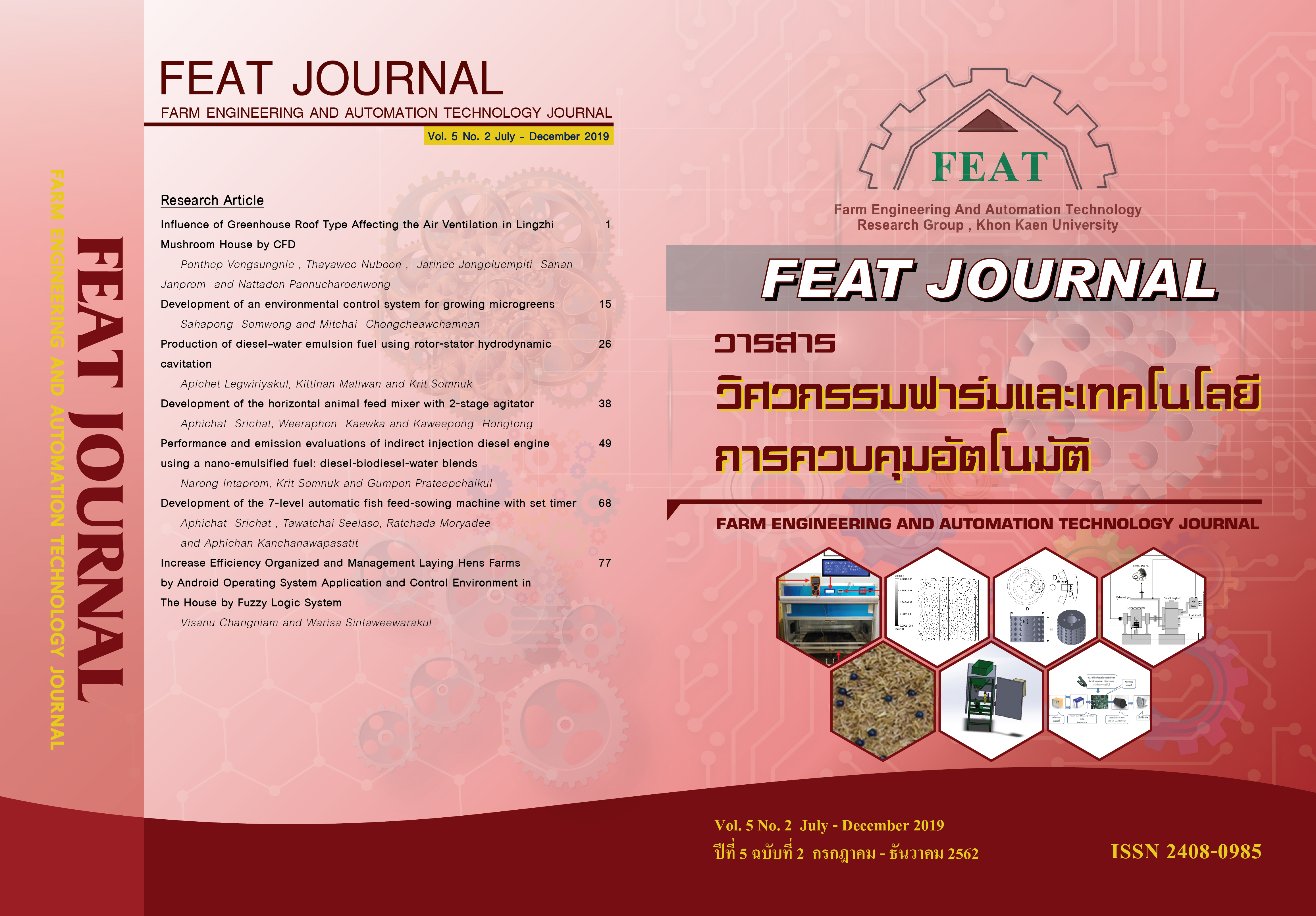การผลิตเชื้อเพลิงอิมัลชัน ดีเซล–น้ำ ด้วยระบบไฮโดรไดนามิกคาวิเทชันแบบโรเตอร์และสเตเตอร์
Main Article Content
บทคัดย่อ
งานวิจัยนี้เป็นการศึกษาเชื้อเพลิงอิมัลชัน ดีเซล–น้ำ ที่ผลิตด้วยเครื่องไฮโดรไดนามิกคาวิเทชันแบบโรเตอร์และสเตเตอร์ เพื่อนำไปวิเคราะห์ความคงตัว ขนาดหยดอนุภาคด้วยกล้องจุลทรรศน์กำลังขยาย 1000 เท่า และค่าการกระจายของขนาดอนุภาค (poly dispersity index, PDI) ของเชื้อเพลิงอิมัลชันด้วยเครื่องวัดขนาดอนุภาคระดับนาโนเมตร ในการศึกษาได้ออกแบบโรเตอร์ที่มีตัวแปรอิสระคือ เส้นผ่านศูนย์กลางของรูเจาะ (4–6 mm) และอัตราส่วนระหว่างเส้นผ่านศูนย์กลางของรูเจาะกับความลึกของรูเจาะ (0.6–1.0) โดยระยะห่างระหว่างโรเตอร์กับสเตเตอร์เท่ากับ 10 mm ความสูงของโรเตอร์เท่ากับ 46 mm และเส้นผ่านศูนย์กลางของโรเตอร์เท่ากับ 70 mm เพื่อนำไปผลิตเชื้อเพลิงอิมัลชัน ดีเซล–น้ำ ซึ่งประกอบด้วย น้ำมันดีเซลเท่ากับ 80 vol.% น้ำเท่ากับ 10 vol.% สารลดแรงตึงผิวชนิด Span80 เท่ากับ 5 vol.% และสารลดแรงตึงผิวชนิด Tween80 เท่ากับ 5 vol.% (สูตร D80W10S5T5) โดยอัตราการการไหลของสารผสมเข้าเครื่องไฮโดรไดนานิกคาวิเทชันเท่ากับ 10.5 L/hr ที่ความเร็วรอบโรเตอร์เท่ากับ 4000 rpm จากผลการทดลองพบว่า โรเตอร์ที่มีขนาดเส้นผ่านศูนย์กลางของรูเจาะเท่ากับ 4 mm และอัตราส่วนระหว่างเส้นผ่านศูนย์กลางของรูเจาะกับความลึกเท่ากับ 0.8 และ 1.0 สามารถผลิตเชื้อเพลิงอิมัลชัน ดีเซล–น้ำ ที่มีระยะเวลาความเสถียรภาพสูงสุดเท่ากับ 60 วัน มีขนาดหยดอนุภาคเฉลี่ยเท่ากับ 3 µm และค่าการกระจายของขนาดอนุภาคเฉลี่ยเท่ากับ 285 และ 271 nm ตามลำดับ ดังนั้นการใช้ไฮโดรได–นามิกคาวิเทชันสามารถผลิตเชื้อเพลิงอิมัลชัน ดีเซล–น้ำ ในขนาดอนุภาคระดับนาโนเมตรได้ ซึ่งมีข้อดี คือ ช่วยเพิ่มประสิทธิภาพในการเผาไหม้ของเชื้อเพลิงในเครื่องยนต์และลดก๊าซไอเสียที่เกิดขึ้นจากเครื่องยนต์ได้ เช่น ก๊าซไนโตรเจนออกไซด์ เป็นต้น
Article Details
วารสารวิศวกรรมฟาร์มและเทคโนโลยีควบคุมอัตโนมัติ (FEAT Journal) มีกําหนดออกเป็นราย 6 เดือน คือ มกราคม - มิถุนายน และกรกฎาคม - ธันวาคม ของทุกปี จัดพิมพ์โดยกลุ่มวิจัยวิศวกรรมฟาร์มและเทคโนโลยีควบคุมอัตโนมัติ คณะวิศวกรรมศาสตร์มหาวิทยาลัยขอนแก่น เพื่อเป็นการส่งเสริมและเผยแพร่ความรู้ ผลงานทางวิชาการ งานวิจัยทางด้านวิศวกรรมศาสตร์และเทคโนโลยีพร้อมทั้งยังจัดส่ง เผยแพร่ตามสถาบันการศึกษาต่างๆ ในประเทศด้วย บทความที่ตีพิมพ์ลงในวารสาร FEAT ทุกบทความนั้นจะต้องผ่านความเห็นชอบจากผู้ทรงคุณวุฒิในสาขาที่เกี่ยวข้องและสงวนสิทธิ์ ตาม พ.ร.บ. ลิขสิทธิ์ พ.ศ. 2535
เอกสารอ้างอิง
[2] กรมพัฒนาพลังงานทดแทนและอนุรักษ์พลังงาน กระทรวงพลังงาน. สถานการณ์การใช้น้ำมันและ ไฟฟ้าของไทย (สื่อออนไลน์). [เข้าถึงเมื่อ 14 พฤษภาคม 2562]. สืบค้นจาก: http://www.eppo.go.th/index.php/th/energy–information/situation–oil–electric?orders[publishUp]=publishUp&issearch=1.
[3] Ithnin AM, et al. An overview of utilizing water–in–diesel emulsion fuel in diesel engine and its potential research study. Journal of the Energy Institute 2014; 87: 273–88.
[4] Vellaiyan S, Amirthagadeswaran KS. The role of water–in–diesel emulsion and its additives on diesel engine performance and emission levels: A retrospective review. Alexandria Engineering Journal 2016; 55: 2463–72.
[5] Vigneswaran R, et al. Experimental investigation of unmodified diesel engine performance, combustion and emission with multipurpose additive along with water–indiesel emulsion fuel. Energy Conversion and Management 2018; 172: 370–80.
[6] Bidita BS, et al. Preparation, characterization and engine performance of water in diesel nanoemulsions. Journal of the Energy Institute 2016; 89: 354–65.
[7] Scarpete D, et al. Effect of water content in diesel–water emulsified fuel on diesel engine performance. International Scientific Journal. 2013; 1: 25-8.
[8] Noor El–Din MR, et al. Performance and exhaust emissions of a diesel engine using diesel nanoemulsions as alternative fuels. Egyptian Journal of Petroleum 2019; 28(2): 197-204.
[9] Ghannam MT, Selim MYE. Stability Behavior of Water–in–Diesel Fuel Emulsion. Petroleum Science and Technology 2009: 27: 396–411.
[10] Norazni SA, et al. Stability behavior of non–surfactant water–indiesel emulsion fuel using microscopic observation [Internet]. MATEC Web of Conferences; 2017 [cited 2016 December 16]. Available from: https://doi.org/10.1051/matecconf/20179001059.
[11] Schalbart P, et al. Formation of tetradecane nanoemulsion by low–energy emulsification methods. International journal of refrigeration 2010; 33: 612–24.
[12] Scholz P, Keck CM. Nanoemulsions produced by rotor–stator high speed stirring. International Journal of Pharmaceutics 2015; 482: 110–7.
[13] Elsanusi OA, et al. Experimental Investigation on a Diesel Engine Fueled by Diesel–Biodiesel Blends and their Emulsions at Various Engine Operating Conditions. Applied Energy 2017; 203: 582–93.
[14] Mura E, et al. Study of the microexplosion temperature of water in oil emulsion droplets during the Leidenfrost effect. Experimental Thermal and Fluid Science 2012; 43: 63–70.
[15] Chakinala AG, et al. Industrial wastewater treatment using hydrodynamic cavitation and heterogeneous advanced Fenton processing. Chemical Engineering Journal 2009; 152: 498–502.
[16] Patil PN, et al. Intensification of biogas production using pretreatment based on hydrodynamic cavitation. Ultrasonics Sonochemistry 2016; 3: 79–86.
[17] Ramisetty KA, et al. Novel Approach of Producing Oil in Water Emulsion Using Hydrodynamic Cavitation Reactor. Industrial & Engineering Chemistry Research 2014; 53: 16508–15.
[18] Carpenter J, et al. Low pressure hydrodynamic cavitating device for producing highly stable oil in water emulsion: Effect of geometry and cavitation number. Chemical Engineering and Processing 2017; 116: 97–104.
[19] Mayvan AA, et al. Intensification of Continuous Biodiesel Production from Waste Cooking Oils Using Shockwave Power Reactor: Process Evaluation and Optimization through Response Surface Methodology (RSM). Energies 2018; 11(10): 1-13.
[20] Ghayal D, et al. Optimization of biodiesel production in a hydrodynamic cavitation reactor using used frying oil. Ultrasonics Sonochemistry 2013; 20: 322–8.
[21] ขวัญจิต อึ๊งโพธิ์. อิมัลชั่นทางเภสัชกรรม. ภาควิชาเทคโนโลยีเภสัชกรรม มหาวิทยาลัยสงขลานครินทร์: สงขลา; 2554.
[22] Mason TG, et al. Nanoemulsions: formation, structure, and physical properties. Journal of physics: condensed matter 2006; 18: 635–66.
[23] Ahmed MI, et al. An overview of utilizing water-in-diesel emulsion fuel in diesel engine and its potential research study. Journal of the Energy Institute 2014; 87: 273–88.
[24] Prakash R, et al. Experimental studies on combustion, performance and emission characteristics of diesel engine using different biodiesel bio oil emulsions. Journal of the Energy Institute 2016; 88: 64–75.


